Doclaura
On this page, you find all documents, package deals, and flashcards offered by seller DocLaura.
- 4420
- 0
- 509
Community
- Followers
- Following
8 Reviews received
4927 items

Glowacki & Sommers RCIS Review Calc Notecards Exam Questions And Answers
Mean Arterial Blood Pressure - ANS (Systolic + 2xDiastolic) / 3 Pulse Pressure - ANS AO Systolic - AO Diastolic Normal O2 Comsumption - ANS Adult - 250 mL/min Child - 150 mL/min FICK Cardiac Output - ANS O2 Consumption (mL/min) / (AVO2 difference) x 10 Stroke Volume (SV) - ANS End Diastolic Volume (EDV) - End Systolic Volume (EDS) Ejection Fraction (EF) - ANS Stroke Volume / End Diastolic Volume Cardiac Output (L/min) Angiograph...
- Exam (elaborations)
- • 2 pages •
Mean Arterial Blood Pressure - ANS (Systolic + 2xDiastolic) / 3 Pulse Pressure - ANS AO Systolic - AO Diastolic Normal O2 Comsumption - ANS Adult - 250 mL/min Child - 150 mL/min FICK Cardiac Output - ANS O2 Consumption (mL/min) / (AVO2 difference) x 10 Stroke Volume (SV) - ANS End Diastolic Volume (EDV) - End Systolic Volume (EDS) Ejection Fraction (EF) - ANS Stroke Volume / End Diastolic Volume Cardiac Output (L/min) Angiograph...
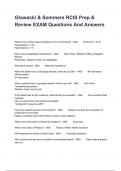
Glowacki & Sommers RCIS Prep & Review EXAM Questions And Answers
What is the normal range of potassium (K+) in the blood? - ANS Normal K+ =3.5-5 Hypokalemia = <3.5 Hyperkalemia = >5 Name some antiplatelet medications? - ANS ASA, Plavix, Brillenta, Effient, Integrelin, Reopro Remember: Heparin is NOT an antiplatelet Adenosine causes - ANS Maximum hyperemia When the patient has a vasovagal reaction, what do you see? - ANS BP decreases HR decreases SV decreases When a patient has a vasovagal reaction what d...
- Exam (elaborations)
- • 3 pages •
What is the normal range of potassium (K+) in the blood? - ANS Normal K+ =3.5-5 Hypokalemia = <3.5 Hyperkalemia = >5 Name some antiplatelet medications? - ANS ASA, Plavix, Brillenta, Effient, Integrelin, Reopro Remember: Heparin is NOT an antiplatelet Adenosine causes - ANS Maximum hyperemia When the patient has a vasovagal reaction, what do you see? - ANS BP decreases HR decreases SV decreases When a patient has a vasovagal reaction what d...
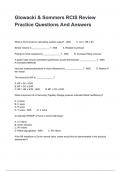
Glowacki & Sommers RCIS Review Practice Questions And Answers
What is the formula for calculating cardiac output? - ANS C. CO = HR x SV Stroke Volume is ______________? - ANS A. Related to preload Preload is most impacted by ______________? - ANS B. Increased filling volumes A patient with chronic untreated hypertension would demonstrate ______________? - ANS A.Increased afterload Vascular resistance/pressure is most influenced by ______________? - ANS D. Radius of the vessel The formula for BP is ____...
- Exam (elaborations)
- • 37 pages •
What is the formula for calculating cardiac output? - ANS C. CO = HR x SV Stroke Volume is ______________? - ANS A. Related to preload Preload is most impacted by ______________? - ANS B. Increased filling volumes A patient with chronic untreated hypertension would demonstrate ______________? - ANS A.Increased afterload Vascular resistance/pressure is most influenced by ______________? - ANS D. Radius of the vessel The formula for BP is ____...
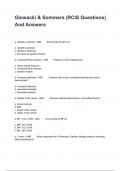
Glowacki & Sommers (RCIS Questions) And Answers
a. related to preload - ANS Stroke Volume (SV) is? a. related to preload b. related to afterload c. the same as ejection fraction b. increased filling volumes - ANS Preload is most impacted by? a. mean arterial pressure b. increased filling volumes c. ejection fraction a. Increased afterload - ANS A patient with chronic untreated hypertension would demonstrate? a. increased afterload b. decreased aferload c. decreased preload d. Radius of the vesse...
- Exam (elaborations)
- • 58 pages •
a. related to preload - ANS Stroke Volume (SV) is? a. related to preload b. related to afterload c. the same as ejection fraction b. increased filling volumes - ANS Preload is most impacted by? a. mean arterial pressure b. increased filling volumes c. ejection fraction a. Increased afterload - ANS A patient with chronic untreated hypertension would demonstrate? a. increased afterload b. decreased aferload c. decreased preload d. Radius of the vesse...

Tactical Combat Casualty Care Exam Questions And Answers
true or false Military Units that have trained all of their members in TCC have documented the lowest incidence of preventable deaths among their casualties in the history of modern warfare - ANS True Trauma docs and combat medical personnel have different skills sets. Both are needed to optimize battlefield trauma care strategies - ANS True what are the common causes of preventable deaths in TCCC? - ANS Extremity Hemorrhage Junctional Hemorrhage Tension Pneum...
- Exam (elaborations)
- • 8 pages •
true or false Military Units that have trained all of their members in TCC have documented the lowest incidence of preventable deaths among their casualties in the history of modern warfare - ANS True Trauma docs and combat medical personnel have different skills sets. Both are needed to optimize battlefield trauma care strategies - ANS True what are the common causes of preventable deaths in TCCC? - ANS Extremity Hemorrhage Junctional Hemorrhage Tension Pneum...
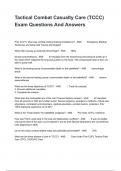
Tactical Combat Casualty Care (TCCC) Exam Questions And Answers
Prior to 9/11, what was combat medical training modeled on? - ANS Emergency Medical Technician and Advanced Trauma Life Support What often causes a junctional hemorrhage? - ANS IEDs tension pneumothorax - ANS Air escapes from the injured lung and pressure builds up in the chest which collapses the lung and pushes on the heart. The compressed heart is then not able to pump well. What is the leading cause of preventable death on the battlefield? - ANS hemor...
- Exam (elaborations)
- • 22 pages •
Prior to 9/11, what was combat medical training modeled on? - ANS Emergency Medical Technician and Advanced Trauma Life Support What often causes a junctional hemorrhage? - ANS IEDs tension pneumothorax - ANS Air escapes from the injured lung and pressure builds up in the chest which collapses the lung and pushes on the heart. The compressed heart is then not able to pump well. What is the leading cause of preventable death on the battlefield? - ANS hemor...
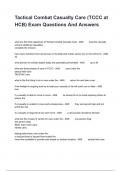
Tactical Combat Casualty Care (TCCC at HCB) Exam Questions And Answers
what are the three objectives of Tactical Combat Casualty Care - ANS treat the casualty prevent additional casualties complete the mission how many members from all services in the DoD and civilian sector are on the CoTCCC - ANS 42 what percent of combat deaths today are potentially preventable - ANS up to 24 what are three phases of care in TCCC - ANS care under fire tactical field care TACEVAC care what is the first thing to do in care under fi...
- Exam (elaborations)
- • 5 pages •
what are the three objectives of Tactical Combat Casualty Care - ANS treat the casualty prevent additional casualties complete the mission how many members from all services in the DoD and civilian sector are on the CoTCCC - ANS 42 what percent of combat deaths today are potentially preventable - ANS up to 24 what are three phases of care in TCCC - ANS care under fire tactical field care TACEVAC care what is the first thing to do in care under fi...
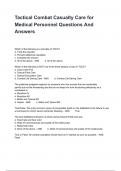
Tactical Combat Casualty Care for Medical Personnel Questions And Answers
Which of the following is a principle of TCCC? a. Treat the casualty b. Prevent additional casualties c. Complete the mission d. All of the above - ANS d. All of the above Which of the following is NOT one of the three phases of care in TCCC? a. Care Under Fire b. Tactical Field Care c. Tactical Evacuation Care d. Combat Life Saving Care - ANS d. Combat Life Saving Care The preferred analgesia regimen for someone who has wounds that are moderately painful but not l...
- Exam (elaborations)
- • 17 pages •
Which of the following is a principle of TCCC? a. Treat the casualty b. Prevent additional casualties c. Complete the mission d. All of the above - ANS d. All of the above Which of the following is NOT one of the three phases of care in TCCC? a. Care Under Fire b. Tactical Field Care c. Tactical Evacuation Care d. Combat Life Saving Care - ANS d. Combat Life Saving Care The preferred analgesia regimen for someone who has wounds that are moderately painful but not l...
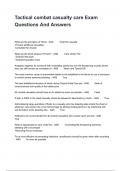
Tactical combat casualty care Exam Questions And Answers
What are the principles of TCCC - ANS -Treat the casualty -Prevent additional casualties -Complete the mission What are the three phases of TCCC? - ANS -Care Under Fire -Tactical Field Care -Tactical Evacuation Care Analgesia regimen for someone with moderately painful but non life threatening wounds where they can still function as combatant is - ANS Mobic and Tylenol ER The most common cause of preventable death on the battlefield is the failure to use a to...
- Exam (elaborations)
- • 9 pages •
What are the principles of TCCC - ANS -Treat the casualty -Prevent additional casualties -Complete the mission What are the three phases of TCCC? - ANS -Care Under Fire -Tactical Field Care -Tactical Evacuation Care Analgesia regimen for someone with moderately painful but non life threatening wounds where they can still function as combatant is - ANS Mobic and Tylenol ER The most common cause of preventable death on the battlefield is the failure to use a to...
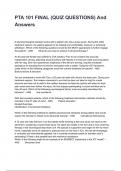
PTA 101 FINAL (QUIZ QUESTIONS) And Answers
A physical therapist assistant works with a patient who has a knee sprain. During the initial treatment session, the patient appears to be relaxed and comfortable, however, is extremely withdrawn. Which of the following questions would be the MOST appropriate to further engage the patient? - ANS What do you hope to achieve in physical therapy? An 83 year-old female has suffered a CVA (stroke). Prior to her incident she was fully independent, driving, attending social functions with fr...
- Exam (elaborations)
- • 12 pages •
A physical therapist assistant works with a patient who has a knee sprain. During the initial treatment session, the patient appears to be relaxed and comfortable, however, is extremely withdrawn. Which of the following questions would be the MOST appropriate to further engage the patient? - ANS What do you hope to achieve in physical therapy? An 83 year-old female has suffered a CVA (stroke). Prior to her incident she was fully independent, driving, attending social functions with fr...

Pre and post test Barkley Exam Questions And Answers
Galen College of Nursing NU110 Exam #2 100% Graded & verified
HS 2712 - Final Exam Prep Question Rated 100% And Answers
Medical Surgical Telemetry B Exam Questions And Answers
NC Locksmith Exam Section 1 Questions And Ans